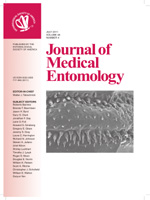The American dog tick, Dermacentor variabilis (Say) (Acari: Ixodidae), has been implicated as a potential bridging vector to humans of Francisella tularensis, the etiological agent of tularemia. Since the initial studies evaluating vector competency of D. variabilis were conducted, F. tularensis has been subdivided into subspecies and clades that differ in their geographical distribution in the United States and in the severity of infections caused in humans. Here, we demonstrate that D. variabilis nymphs efficiently acquire, transtadially maintain, and transmit each of the strains tested (clades A1b and A2, and type B). Transmission efficiency by adult females was similarly high among infection groups and ranged from 58% for type B to 89% for A2 infections. In addition, we demonstrated that transmission can occur shortly after tick attachment. These findings support the concept that D. variabilis adults may play a significant role in epizootic transmission of F. tularensis, and as a bridging vector to humans.
How to translate text using browser tools
1 July 2011
Transmission Efficiency of Francisella tularensis by Adult American Dog Ticks (Acari: Ixodidae)
Sara M. Reese,
Jeannine M. Petersen,
Sarah W. Sheldon,
Marc C. Dolan,
Gabrielle Dietrich,
Joseph Piesman,
Rebecca J. Eisen
ACCESS THE FULL ARTICLE
It is not available for individual sale.
This article is only available to subscribers.
It is not available for individual sale.
It is not available for individual sale.

Journal of Medical Entomology
Vol. 48 • No. 4
July 2011
Vol. 48 • No. 4
July 2011
Dermacentor variabilis
tick-borne diseases
tularemia
vector competency
vector efficiency




